A NEW BEGINNING: BRONZES OF THE SONG AND YUAN (lots 1-4) |
    |
A TRIPOD BRONZE INCENSE BURNER.
Yuan to Ming Dynasty.
The globular body decorated with frothing waves and rising to an onion neck formed as a flowering lotus with two rows of overlapping petals, the body supported on three feet emerging from dragon heads, and resting on a stepped circular stretcher.
13.5cm H.
550g.
£600-800
The form of the present censer is highly unusual. A prototype can be found in qingbai ware of the Song Dynasty. For example, see Rose Kerr, Song Dynasty Ceramics, 2004, p 102, fig 103, for a 13th Century Qingbai incense burner formed as a bow with moulded lotus petals supported on a pedestal encircled by a dragon and raised pierced gallery around the foot [below left]. A related bronze vessel may be found in the Yuan Dynasty painting Whiling Away the Summer by Liu Guandao in the collection of the Nelson-Atkins Gallery [below centre]. The form also extended into the early Ming with a tripod lotus mouth censer from the early Yongle period included in Imperial Porcelain of the Yongle and Xuande Periods Excavated from the Site of the Ming Imperial Factory at Jingdezhen, 1989, cat no 2, p 86 [below right].
|
|

|
A BRONZE INCENSE STICK HOLDER.
Yuan Dynasty.
The cylindrical parfumier with two chilong handles with S-shaped bodies their mouths fixed to the rim, the body pierced with four ruyi-shaped panels each applied with an Immortal riding above a ground of swirling waves, and below a band of phoenixes against a leiwen ground.
18cm H, 19cm across.
1.298kg.
£500-800
|
|

|
A PEAR-SHAPED VASE.
Yuan Dynasty.
The pear-shaped body rising to a waisted neck rising to a stepped rim and supported on a stepped foot, the shoulders flanked by a pair of handles emerging from mythical beast heads.
34.5cm H.
2.75g.
£1,500-2,000
|
|
  |
A BRONZE FANGHU.
Song to Yuan Dynasty.
Of rectangular form, the pear-shaped body rising from a splayed foot to a waisted neck and slightly flared mouth, the four sides separated by vertical ridges and divided into quadrants by horizontal ridges each enclosing tightly patterned motifs including upright cicada leaves, wan and linked-coins, the neck flanked by a pair of cloud swirl handles, the foot bordered by frothing waves.
19cm H.
518g.
£6,000-8,000
This vase is widely considered to be of a quintessential Song/Yuan bronze type. Patterns on this group of vases vary greatly, however, the present piece remarkably is identical in decoration, form and size to the piece excavated in Siziwang Banner, Wulanchabu, Inner Mongolia, 1956, and illustrated in James C.Y. Watt, The World of Khubilai Khan: Chinese Art in the Yuan Dynasty, p 290, figure 337, although of far superior condition [below].
| TWO BRONZE WEIGHTS FROM PRIVATE BRITISH COLLECTIONS (lots 5-6) | |
|
    |
A GILT BRONZE 'XIEZHI' WEIGHT.
Ming Dynasty.
The beast standing foursquare on a low rectangular base, the head raised behind, and the tail curled around the left hind leg, incised two character Xuande mark to base.
3.5cm H, 4.5cm long.
85g.
Provenance: British Private Collection.
£2,000-3,000
Xuande mark and period bronzes have been dubbed 'the holy grail' of Chinese bronzes for their elusive and almost mythical quality. Gerard Hawthorn ascribes two bronzes with inscribed Xuande marks to the period, see Sotheby's, Later Chinese Bronzes from the Collection of Mr and Mrs Gerard Hawthorn, 2015, lots 9 and 34. Incised marks were certainly present on Xuande mark and period cloisonné enamel pieces as attested by three examples in the collection of the Palace Museum, Beijing, see Compendium of Collections in the Palace Museum, 2011, p 128, cat no 54; p 130 cat no 55; and p 138, cat no 60, however, in all three examples the characters are incised in outline and so do not bear direct comparison. Inscribed marks securely dateable as of the period can be found in other media, for example, see a cinnabar lacquer table in the collection of the V&A Museum, with six character incised Xuande mark and of the period, see F. Low-Beer, 'Chinese Lacquer of the Early 15th Century', Bulletin MFEA, 22, Stockholm 1950, pl 14-18, p 151v [below left], or a yellow glazed bowl, with six character mark, and of the period, illustrated in Regina Krahl, Chinese Ceramics from the Meiyintang Collection, 1994-2010, vol 4, no 1665 [below right].
|
|
   |
A BRONZE 'QILIN' WEIGHT.
Ming Dynasty.
Cast as a seated the head turned to the left, the base cast with four character Xuande nian zao mark.
4cm H.
295g.
Provenance: English private collection; Gerard Hawthorn Ltd, Oriental Art, 1998, cat no 28.
£1,000-2,000
| SILVER-INLAID BRONZES (lots 7-11) | |
|
  |
A SILVER-INLAID BRONZE 'DRAGON AND PHOENIX' VASE, HU.
Qing Dynasty, 18th Century.
Cast with a globular body rising from a splayed stepped foot to a waisted ribbed neck and a flared mouth-rim, the shoulders cast with a pair of taotie mask handles suspending loose rings with silver inlay, the body finely inlaid in silver with alternating dragon and phoenix roundels, above a leiwen and lappet band at the foot, further lappet, ruyi head and leiwen bands to the neck, six character Xuande mark to base.
22.7cm H.
2.377kg.
£500-800
|
|
  |
A SILVER-INLAID BRONZE VASE.
Qing Dynasty, 18th Century.
The ovoid body with wide shoulders sweeping to a flared mouth, the body finely decorated in silver inlay with two taotie masks and a pair of Buddhist lion dogs, below a band of scrolling foliage, set to the shoulders with a pair of naturalistically modelled bird handles borne on a leafy bamboo stem also finely detailed with inlaid silver.
32.5cm H.
8.65kg.
£400-600
|
|

|
A SILVER-INLAID BRONZE FANGDING.
17th Century.
Of rectangular section, raised on four cylindrical feet with lotus scroll patterns inlaid in silver, each face with a lower panel incised with a taotie divided by a vertical flange and an upper panel with a geometric pattern, each outlined with bands of silver inlay, the four corners divided by vertical protruding flanges and the mouth rim is set with a pair of upright loop handles.
21.7cm H.
2.65kg.
£1,000-2,000
|
|
  |
A SILVER-INLAID BRONZE WALL VASE.
Qing Dynasty, 18th to 19th Century, signed Shisou.
The flat-back vase with a rounded rectangular body raised on a slightly splayed foot, tapering to a waisted neck beneath a flaring mouth, flanked by a pair of iron-red and dragon handles, the body, shoulders and neck inlaid in silver with geometric patterns, the back with inlaid Shisou mark.
16cm H.
508g.
£800-1,200
|
|
  |
A MINIATURE SILVER-INLAID BRONZE VASE.
17th to 18th Century, signed Shisou.
The pear-shaped bottle-form vase with a waisted neck with a single raised band, the faceted and lobed garlic-head below a cylindrical mouth, silver inlaid decoration to the body and an inlaid Shisou mark to the base.
10cm H.
289g.
£100-200
| A TOUCH OF GOLD: GILT BRONZE FIGURATIVE SCULPTURE (lots 12-15) | |
|

|
A GILT-LACQUER BRONZE FIGURE OF GUANYIN.
Ming Dynasty, 17th Century.
Seated in dhyanasana, dressed in loose, flowing robes, the contemplative face framed by the knotted plaits and elongated earlobes suspending ornate earrings, the head supporting an elaborate openwork tiara.
26cm H.
2.534kg
£1,200-1,500
|
|

|
A GILT BRONZE FIGURE OF GUANYIN.
Ming Dynasty, 17th Century.
Seated in dhyanasana, dressed in loose, flowing robes with chased floral borders, the contemplative face framed by the knotted plaits and ornate earrings, the head supporting an elaborate openwork tiara.
20cm H.
1.213kg.
£3,000-5,000
|
|

|
A GILT-LACQUER BRONZE FIGURE OF BUDDHA.
Ming Dynasty.
The smiling, corpulent figure is seated beside his red lacquered sack which he holds in his left hand while holding prayer beads in his right, and his belted robe is worn loosely, exposing his belly.
21cm H, 16cm wide.
3.128kg.
£2,000-3,000
|
|

|
A GILT-LACQUER FIGURE OF ANANDA.
Ming Dynasty.
Standing upright on a circular lotus petal base with hands joined in anjalimudra, dressed in wide long-sleeved monk's robes, the full face with downcast eyes and reverent expression.
21.5cm H.
929g.
£500-800
| THE ART OF THE FLOWER VASE (lots 16-26) | |
|
  |
A BRONZE GARLIC NECK 'DRAGON' VASE.
Early Qing Dynasty.
The pear-shaped bottle-form vase with waisted neck, the lobed 'garlic-head' below lipped ring, all on a spreading stepped foot, the neck and body encircled by a chilong, two character Xuande mark.
42cm H.
6kg.
£2,000-3,000
|
|
  |
A BRONZE GARLIC MOUTH VASE.
17th Century.
The pear-shaped bottle-form vase with a waisted neck with a single raised band, the faceted and lobed 'garlic-head' below a cylindrical mouth, incised six character Da Ming Xuande nian zao mark to foot.
40cm H.
4.35kg.
£3,000-5,000
|
|
  |
A BRONZE LANÇA VASE.
Qing Dynasty, 18th Century.
A quadrilobed baluster form with the everted stepped base rising to high rounded shoulders, a waisted neck and everted rim, the shoulders flanked by a pair of five claw dragon form handles, alternating with lança script, a row of flower head bosses between ribbed bands to the neck and repeated above the base, six character Xuande mark to base, wood stand. (2)
39.5cm H.
5.11kg.
£4,000-6,000
|
|

|
A BRONZE VASE, GU.
17th Century.
Of archaistic gu form with protruding central section, widely flaring to the trumpet mouth and supported on a splayed foot, divided vertically by flanges into four quadrants, the neck with cicada leaves, the mid and lower sections with archaic designs.
39cm H.
4.8kg.
£600-800
|
|

|
A BRONZE VASE, HU.
17th to 18th Century.
The globular body rising from a splayed foot to a waisted neck, the body with concentric bands, the shoulders cast with a pair of taotie mask handles suspending loose rings.
36cm H.
4.5kg.
£3,000-5,000
|
|

|
A BRONZE VASE, FANGGU.
Late Ming Dynasty.
The slender vase of square section, cast with a splayed foot rising to a trumpet neck, the neck cast with archaic cicada lappets, the central section with two taotie masks across the four faces and four taotie masks on the foot.
28.5cm H.
1.5kg.
£400-600
|
|
  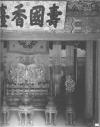  |
A PAIR OF BRONZE VASES.
Ming Dynasty.
Each of pear shaped form, on a spreading foot and rising to a flared rim, the waisted neck decorated with rounded studs decorated in whorl circles, between two narrow raised ribs, the ribs enclosed by open ruyi head handles suspending rings. (2)
27cm H.
2.3kg. 2.6kg.
Provenance: Formally in an English private collection.
£6,000-8,000
The form of the present pair of vases apparently emerged in the early Ming Dynasty. A gilt bronze version of this vase, with Xuande mark, and apparently of the period, as verified by local gazettes and contemporary stone stele, was Imperially commissioned for the Quran Monastery in Qinghai province, see Cultural Relics of Hehuang, 2012, p 234 [below left]. Vases of this form are also present at the Imperial court and one is clearly visible in the photograph of the inner room of the Forbidden City published in Architecture of the Forbidden City, Classics of Forbidden City, 2007 [below centre]. Furthermore, the form of vase formed a model for the Imperial ceramic workshops of the 16th Century who also added surface decoration to their output. An example of similarly formed vases, but with dragon designs to the body, with Jiajing mark and of the period, can be found in the collection of the British Museum, Jessica Harrison Hall, Ming Ceramics in the British Museum, 2001, cat no 9:57 and 9:58 [below right].
|
|

|
A BRONZE VASE, GU.
17th to 18th Century.
With a gently flaring rim and spreading foot, the rounded central section with four wide evenly spaced flanges.
31cm H.
2.35g.
£400-600
|
|

|
A HEXAGONAL BRONZE VASE.
Ming Dynasty.
Of hexagonal form, the pear-shaped body rising from a splayed foot, flanked by a pair of loop handles issuing from dragon heads, the shoulders set with diaper pattern panels to each face, the body with panels enclosing taotie masks, and a band of scrolling foliage to the foot.
17cm H.
1.45kg.
£800-1,200
|
|

|
A BRONZE VASE, HU.
Qing Dynasty.
Rising to rounded shoulders from a spreading neck with waisted neck and everted rim, the body shoulders and neck each with a band of taotie masks above a hand of pendant cicada lappets, the shoulders set with circular loop handles suspending rings.
34.5cm H.
4.3kg.
£1,200-1,500
|
|

|
A PARCEL-GILT BRONZE VASE.
Late Ming Dynasty.
Of baluster form, the rounded body with wide shoulders, supported on a spreading foot and rising to a trumpet neck, the shoulders with a pair of taotie mask handles suspending loose rings and cast in low relief with a band of taotie masks against a leiwen ground, all above pendant cicada blades, with details accented in gilt.
41cm H.
5.15kg.
£6,000-8,000
| BRONZE CENSERS FROM AN ENGLISH PRIVATE COLLECTION (lots 27 - 47) | |
|
  |
A BRONZE 'LOTUS POND' INCENSE BURNER, LIDING.
17th Century.
Of liding, form, the globular body supported on three short feet, the rim surmounted by a pair of arched handles, the body decorated with two panels extending down the legs with lotus plants and birds and insects among plum blossoms.
6.2cm H, 10.2cm diameter.
585g.
£3,000-5,000
|
|
  |
A LARGE BRONZE TWIN HANDLED 'DRAGON' INCENSE BURNER.
17th Century.
Of bombé form, supported on tripod cabriole legs, the shoulders set with two upright handles shaped as scaly dragons with fierce expressions, the base with an eight character Da Ming Xuande wu nian jian zhi mark (made under supervision in the fifth year of Xuande emperor in the Ming dynasty).
15cm H, 26.5cm diameter.
5.59kg.
£5,000-8,000
|
|
  |
A LARGE BRONZE PARCEL-GILT 'BAMBOO' INCENSE BURNER.
Early Qing Dynasty, signed Li Yuanhe.
The cylindrical body modelled as a bamboo stem in three nodular sections, supported on bowed tripod feet formed as three smaller stems, the sides set with leafy branches, naturalistically modelled in high relief, covered overall with splashes of gilt, laterally inverted four character Li Yuanhe zhi mark in a recessed panel to the base.
17cm H, 20.3cm diameter.
4.15kg.
£3,000-5,000
Li Yuanhe appears to be unrecorded in traditional connoisseurship. It is possible, however, that zhi means 'made for' rather than 'made by' in which case it is more likely the name of the patron.
|
|
|
|
  |
A BRONZE 'LOTUS SCROLL' INCENSE BURNER, GUI.
Early Qing Dynasty.
Finely cast of bombé form rising from a spreading foot, set with two lion-head handles, the sides crisply cast with lotus scroll, below a leiwen band to the rim and a lappet and spiral band above the foot the base with apocryphal six-character Xuande mark.
7.5cm H, 10cm diameter.
500g.
£800-1,200
|
|
 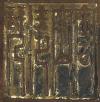 |
A BRONZE TRIPOD INCENSE BURNER.
Qing Dynasty.
The globular body supported on short, bowed conical feet, the rim with thick rounded handles, four character kongshan qing qin mark to base.
10.2cm H, 12cm diameter.
1.92kg.
£2,000-3,000
|
|
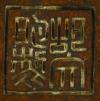  |
A BRONZE 'BAGUA' INCENSE BURNER, LIAN.
Ming Dynasty, signed Hu Wenming.
Of cylindrical form, with a band of eight trigram symbols sandwiched between bands of auspicious symbols, on short tripod feet, four character Hu Wenming zhi mark to base.
8.4cm H, 10cm diameter.
555g.
£3,000-5,000
|
|

|
A BRONZE 'SHOULAO' INCENSE BURNER.
Early Qing Dynasty.
The figure forming the cover, and seated in long flowing robes riding a stag, the animal with the antlered head turned downwards to the left and the front left leg cocked, supported on stand of quadrilobed section on four feet with ruyi head windows. (2)
29.5cm H.
1.58kg
£500-800
|
|
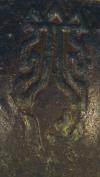  |
A BRONZE INCENSE BURNER, DING.
Ming Dynasty.
Of archaistic form, the compressed hemispherical bowl rising from three long curved legs in the shape of stylised kui dragons, flanked by a pair of upright loop handles, the exterior cast with six raised flanges separating panels of additional dragons against a leiwen ground, the interior with a pictogram reading Beichuan fu yi (Father of Beichuan).
14cm H, 12.5cm diameter.
1.051kg
£1,000-1,500
|
|
  |
A BRONZE INCENSE BURNER.
17th Century.
The low cylindrical body encircled by a raised horizontal band, rising to a wide everted rim with beaded edge, supported on tripod elephant head feet, the base with a six character Xuande mark cast within two dragons encircling a flaming pearl.
7.3cm H.
1.08kg.
£2,000-3,000
|
|
   |
TWO BRONZE TRIPOD INCENSE BURNERS.
Qing Dynasty.
Each on conical feet with loop handles to the rim and six character Xuande marks to the base. (2)
7cm H, 12.2cm diameter; 5cm H, 9cm diameter.
810g; 230g.
£800-1,200
|
|

|
A BRONZE INCENSE BURNER, GUI.
Late Ming Dynasty.
Of archaistic gui form, the gently rounded body supported on a deep, splayed foot, the twin bifurcated handles emerging from the mouth of a mythical beast.
10.8cm H, 15.5cm diameter.
2.25kg.
£1,200-1,500
|
|
  |
A BRONZE 'DRAGONS' INCENSE BURNER.
Qing Dynasty.
Of rectangular section with rounded sides, supported on four feet issuing from the mouths of lion masks, the stepped rim supporting two coiled dragon handles, the body well cast in relief with a forward-facing dragon coiled among swirling clouds, above a pearl resting on a wave, six character Qianlong mark to base.
11cm H.
2.355kg.
£6,000-8,000
|
|
  |
A BRONZE INCENSE BURNER, GUI.
Qing Dynasty.
Of archaistic gui form, cast with a taotie mask on each side and flanked by mythical beast projecting loop handles, four character Xuande mark in seal script within a recessed panel to the base.
8cm H.
860g.
£1,000-1,500
|
|
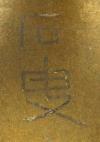  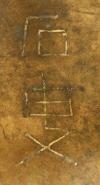 |
TWO SILVER-INLAID BRONZE INCENSE BURNERS.
Qing Dynasty, signed Shisou.
Each with a globular body supported on tall cylindrical feet, with a galleried rim supporting looped handles, inlaid Shisou mark to base. (2)
10cm H, 6.5cm diameter; 9.5cm H, 6cm diameter.
390g; 338g.
£600-800
|
|

|
A BRONZE INCENSE BURNER, GUI.
Ming Dynasty.
Of archaistic gui form, the rounded body supported by a splayed foot, the body set with handles emerging from mythical beast heads, a band of archaistic raised patterns within two rope-twist bands to the shoulders, the design repeated around the foot.
8cm H, 11.8cm diameter.
570g.
£300-500
|
|

|
A BRONZE 'LION' INCENSE BURNER.
Ming Dynasty.
Naturalistically cast seated with large flame-like bushy tail and with one paw resting on a brocade ball, large bulbous eyes and mouth open to reveal sharp teeth and a tongue, the cover set into the back. (2)
14.5cm H.
955g.
£300-500
|
|
  |
A BRONZE INCENSE BURNER, GUI.
Ming Dynasty.
The bombé body rising from a spreading foot to a flared rim, flanked by a pair of loop S-shaped handles, emerging from beneath a ruyi head, six character Xuande mark to base.
6.8cm H, 15.5cm diameter.
1.91kg.
£2,000-3,000
For a related bronze incense burner see Selected Bronze Censers of the Ming and Qing Dynasties, 2015, cat no 153, p 166.
|
|

|
A BRONZE 'EIGHT BUDDHIST EMBLEMS' INCENSE BURNER.
Qing Dynasty.
The rounded body supported on tall cylindrical legs, with the eight Buddhist emblems around the body, the rim supporting loop handles.
15.2cm H, 13cm diameter.
1.12kg.
£800-1,200
|
|
  |
A BRONZE INCENSE BURNER, GUI.
17th Century.
The bombé body rising from a spreading foot, flanked by a pair of loop handles, decorated overall with small irregular splashes of gold, the base impressed with a six character Xuande mark.
10.6cm H, 20cm diameter.
3.42kg.
£3,000-5,000
|
|
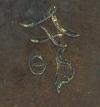  |
A BRONZE 'BUDDHIST SYMBOLS' INCENSE BURNER, LIAN.
Ming Dynasty, signed Hu Wenming.
Of cylindrical form, supported on tripod ruyi head feet, the body with a band of eight Buddhist symbols sandwiched between two small bands of flower heads, divided by raised bands, twin lion head handles, bands of auspicious symbols, on short tripod feet, two character Wenming mark to base.
8.7cm H, 11.1cm diameter.
545g.
£3,000-5,000
| WEARABLE BRONZE: BELT HOOKS AND BUCKLES (lots 48-53) | |
|

|
A GILT BRONZE 'QILONG' BELT SET.
Qing Dynasty.
The hook cast with a dragon-head terminal facing an undercut chilong on a square stem, the facing section similarly decorated. (2)
9cm long.
82g.
£600-800
|
|

|
A GILT BRONZE HARDSTONE INLAID BELT SET.
Qing Dynasty.
The dragon head hook connected to a shaft inset with three coloured hardstones against a ground of raised scrolling foliage, the buckle similarly decorated with a single hardstone. (2)
10cm long.
79g.
£700-900
|
|

|
A GILT BRONZE BELT HOOK SET.
Qing Dynasty, 18th Century.
Cast with a dragon-head terminal facing an undercut chilong on the arched stem, a flat circular knob on the underside, with a hanging-basket form attachment inset with a red stone. (2)
12cm long.
86g.
£800-1,200
|
|

